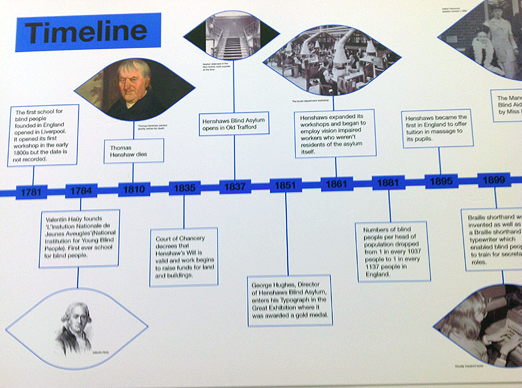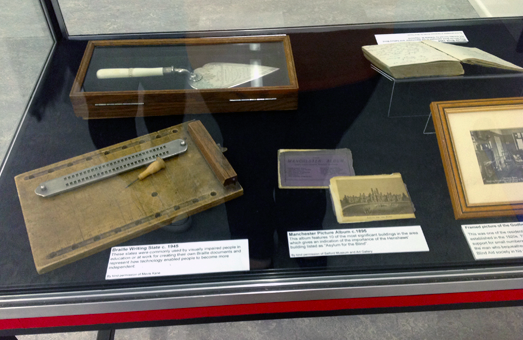I visited the Imperial War Museum North recently, with the Art Galleries and Museums group from Henshaws, where the overall theme of this month's visit focused around the emotional aspect of 'the effects of conflict and war on people in their homes'.
The visit was split into three sections; first exploring the WithDraw exhibition by George Butler, before moving onto a touch and handling session of historical Blitz and Rationing items from the Second World War. Audio description was provided by Carisse Foster, Martin Skelton and Helen Grice who lead the sessions. The visit was arranged by Camilla Thomas and Rosemary Mawdsley.
During the first session, in the Waterway exhibition, the group and I looked at journalist and leading reportage illustrator George Butler's works based on his time in war-torn Afghanistan. He visited last year, in 2014, in the weeks following the drawback of International combat troops after 13 years of conflict.
Butler's pen and ink drawings offer a compelling insight into a country living with high levels of tension. His style of art is very similar to that of an urban sketching technique, something I have been interested in experimenting with for a while, and all were created live, 'in-situ', on the streets of Afghanistan. Most of his pieces are accompanied with his own thoughts and memories printed underneath, revealing the impact of the past 13 years on people, communities and society.
There are twenty exhibits that make up WithDraw, with subjects ranging from people to prosthetics, hospitals and schools, countryside and market streets. All were created using a dip pen and ink on location, and later filled in with watercolours back in the studio.
From the exhibition: "George believes that reportage illustration is as valid, viable and as powerful as photography and film in recording today's news. As an artist and illustrator he is free to interpret the elements that inspire him and sees drawing as a way to offer the viewer a different angle. His drawing is an open process that anyone can view over his shoulder and, he finds, is a sensitive way of capturing very emotional subject matters."
The WithDraw film is available to watch at the exhibition providing a behind-the-scenes insight into how the series of drawings were created in Afghanistan, like a video diary and personal journey. The film is also featured on George Butler's official website landing page, here.
You can find out more about WithDraw, with an upcoming 'Meet the Artist' event with George Butler, on Sunday 23rd August 2015, at the Imperial War Museum website here.
The visit was split into three sections; first exploring the WithDraw exhibition by George Butler, before moving onto a touch and handling session of historical Blitz and Rationing items from the Second World War. Audio description was provided by Carisse Foster, Martin Skelton and Helen Grice who lead the sessions. The visit was arranged by Camilla Thomas and Rosemary Mawdsley.
Above is a selection of George Butler's works that I photographed
During the first session, in the Waterway exhibition, the group and I looked at journalist and leading reportage illustrator George Butler's works based on his time in war-torn Afghanistan. He visited last year, in 2014, in the weeks following the drawback of International combat troops after 13 years of conflict.
Butler's pen and ink drawings offer a compelling insight into a country living with high levels of tension. His style of art is very similar to that of an urban sketching technique, something I have been interested in experimenting with for a while, and all were created live, 'in-situ', on the streets of Afghanistan. Most of his pieces are accompanied with his own thoughts and memories printed underneath, revealing the impact of the past 13 years on people, communities and society.
There are twenty exhibits that make up WithDraw, with subjects ranging from people to prosthetics, hospitals and schools, countryside and market streets. All were created using a dip pen and ink on location, and later filled in with watercolours back in the studio.
The WithDraw film is available to watch at the exhibition providing a behind-the-scenes insight into how the series of drawings were created in Afghanistan, like a video diary and personal journey. The film is also featured on George Butler's official website landing page, here.
You can find out more about WithDraw, with an upcoming 'Meet the Artist' event with George Butler, on Sunday 23rd August 2015, at the Imperial War Museum website here.
The next session in our visit focused around a touch and handling element of historical items from World War 2; particularly collections pertaining to the Blitz and Rationing. As I'm basing my A Level project on this visit I wanted to create Frottage impressions, using a pencil and paper, to get an idea of some of the different surface areas and textures of these items to incorporate into my own research.
We first looked at shrapnel and rubble collected by nine year old Roy Taylor, in his home area of Manchester during the Blitz. Items included brick, slate, shrapnel and cartridges that he found among the rubble and would have played with. These items were cold to the touch, some smooth and dull like the cartridge and others with sharp pointed edges. Also passed around was a metal Victory Bell moulded from fallen German aircraft, a wooden ratchet (or hand rattle) to alert communities of gas attacks, and a baby's gas mask that covered their entire body.
This was my favourite object in our touch and handling session and the sheer weight of the thing was astounding! The mask acted more like a casing, completely encompassing the baby when all of the covering straps and flaps were closed up. Fresh air was pumped in using a hand pump on the right-hand side, that filtered the air ensuring no gas was inhaled. A cage on the back was used to hook baby onto the wall and out of the way - though they would still need fresh air pumped in manually 24 hours a day! Many of these masks were made in Manchester by P. Frankenstein & Sons.
We first looked at shrapnel and rubble collected by nine year old Roy Taylor, in his home area of Manchester during the Blitz. Items included brick, slate, shrapnel and cartridges that he found among the rubble and would have played with. These items were cold to the touch, some smooth and dull like the cartridge and others with sharp pointed edges. Also passed around was a metal Victory Bell moulded from fallen German aircraft, a wooden ratchet (or hand rattle) to alert communities of gas attacks, and a baby's gas mask that covered their entire body.
This was my favourite object in our touch and handling session and the sheer weight of the thing was astounding! The mask acted more like a casing, completely encompassing the baby when all of the covering straps and flaps were closed up. Fresh air was pumped in using a hand pump on the right-hand side, that filtered the air ensuring no gas was inhaled. A cage on the back was used to hook baby onto the wall and out of the way - though they would still need fresh air pumped in manually 24 hours a day! Many of these masks were made in Manchester by P. Frankenstein & Sons.
To end the touch and handling session, and our visit, we looked at various items of Rationing belonging to a Manchester couple who married during the Second World War. The wife's wedding dress was passed around first, which incorporated beautiful lace detailing and a scalloped neckline with pointed V sleeves. This would have been passed down from bride-to-bride through the generations, just one example of rationing.
We also looked at the husband's heavyweight sock that he wore whilst in the Royal Navy. This seems to be a Government-made sock as the stitching is perfect, but many women across the country would have banded together to created garments for soldiers. A darning mushroom was used to repair socks seamlessly, so that nothing ever went to waste and was thrown away - another example of rationing.
Ration books of the married couple, example food portions, canned dried eggs, and a brooch made from a button and telephone wire were also among the collection of rationing items. These were truly frugal times, people had to be creative when restoring or creating items and this is something that has been lost over the generations as we now tend to throw things out and purchase new items.
I thoroughly enjoyed my visit and look forward to working on my A Level summer project with this research! I'd like to say a big thank you to Mary Gifford, Mary Tantrum, Carisse Foster, Martin Skelton, Helen Grice, Camilla Thomas and Rosemary Mawdsley for a well-organised and informative event!



















































































